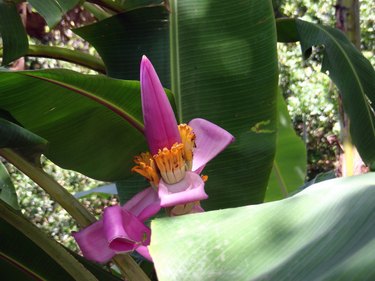
A tropical staple, bananas are a favorite household fruit, available in grocery stores year-round. There are over 1,000 different types of banana plants grown in warm climates, from the cavendish to plantain. When growing bananas, once a bunch has set, you can choose to cut off the flowers since no more bananas will be produced at that point.
When to Cut Flowers From Banana Plants
Video of the Day
In most cases, the stalks of bananas grow in late summer and then winter over. In rare cases, however, they may develop in early summer and become ripe before it gets to be too cold. In most cases, banana plant flowers bloom around the following April, May or June, depending on how warm the temperatures are.
Video of the Day
The first set of flowers to bloom from the flower stalk are the female flowers, a purple flower sitting atop a long stalk. Bananas are seedless fruits, so the female banana flowers produce fruit without pollination. Several banana clusters, referred to as "hands," will form on a single stalk, creating a bunch.
the bunch forms and sets, the banana plant's flowering stalk will continue to grow and flower; however, it will only produce male banana plant flowers at this point. If you choose, you can cut the flower stalk below the developing banana bunches. There is no overriding reason to do so: the flower has no impact on the developing fruit. It is, however, edible, so you may want to cut it off to eat it. Banana flowers can be eaten both raw and cooked, are often sold at roadside stands in the areas where they are grown, and are also known as kele ka phool in many Asian cuisines. These flowers are an excellent source of vitamin c, beta-carotene, protein, calcium, fiber and a number of other vitamins and nutrients.
Banana Plant Anatomy and Care
Banana plants are not trees but giant herbaceous plants, meaning that they do not become woody like trees. The main stem of the banana plant is located underground, growing horizontally. Out from this stem grows the pseudostem, which is the shoots of the plant tightly wrapped together. From the pseudostem grows the flower stalk and leaves.
Banana plants thrive in tropical and subtropical climates. They can withstand cooler climates but will stop growing when temperatures drop below 59 degrees Fahrenheit. Banana plants are best planted in the spring and summer, with ample room for them to spread. They prefer direct sun for at least six hours of the day and rich, well-drained soil.
During warmer months, water banana plants every few days to maintain moist soil but avoid soaking them. Banana plants require potassium-enriched plant food every eight weeks from spring to early autumn.
Types of Banana Plants
The cavendish banana (Musa acuminata 'Dwarf Cavendish,' USDA hardiness zones 10 to 11) is the type of banana most commonly found in grocery stores, making up almost the entire global export market. Named after the Musa Cavendishii, the first modern-day banana was grown in 1830 at Chatsworth House in the UK. Unfortunately, this banana variety has been globally impacted by a serious fungal disease, Fusarium wilt, which has limited its availability.
Another common type of banana is the plantain (Musa sapientum, USDA hardiness zones 8 to 11). Like the popular cavendish, plantains have three different levels of ripeness: green, yellow and black. However, their taste differs significantly from cavendish bananas. Green plantains are starchy and are usually boiled and mashed. Yellow plantains are sweeter and are typically baked, fried or mashed, while black plantains are usually reserved for dessert.
Blue java bananas (Musa acuminata x Musa balbisiana, ABB group, USDA hardiness zones 8 to 11) are a variety of bananas with a blue skin that ripens to yellow. They're also referred to as ice cream bananas because of their creamy texture and vanilla ice cream flavor.
- Royal Botanic Gardens Kew: Cavendish Banana
- Banana Link: All About Bananas
- Nola: Banana Plants
- Better Homes and Gardens: How to Grow Bananas and Care for Banana Plants
- Time: What We Can Learn From the Near-Death of the Banana
- Brightly: Are Our Beloved Bananas Really on the Brink of Extinction?
- Fast Growing Trees: Banana Tree Care and Growth
- Stark Bro's: Harvesting Banana Plants